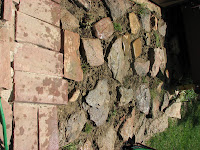
My husband came home from work with a bagful of chokecherries he picked so we had to figure out something to do with them. The most obvious use of chokecherry is as a syrup to be used in the winter for coughs (as well as being delicious on ice cream, pancakes, drinks or anywhere else you would use a syrup). Typically choke cherries are very bitter and astringent in taste, but these are actually very sweet; possibly because they were growing by a stream and getting more water. Chokecherries are very high in ellagic acid. Since I have been reading lately of the benefits of ellagic acid in skin care I wanted to

find some use for these fruits for skin, perhaps a face mask.

Face Mask
Mix
3 tablespoons chokecherry juice
1 tablespoon bentonite clay
2 teaspoons avocado oil
Mix to a nice consistency and smear on your face. Now enjoy a cup of tea while the mask sets on your face. After 10 minutes or so use a wet washcloth to wipe the mask off your face.
Chokecherry Juice
To make a juice put chokecherries in a saucepan to fill about 2/3 full. Fill with water almost to the level of the top of the cherries. Bring water to a gentle boil for 30 minutes or so. Put cherries through some type of press such as used to make jam. I use a device used to make applesauce. Allow juice to drain into a separate bowl while skins and seeds remain behind.
Chokecherry Syrup
For chokecherry syrup I mixed 3 cups of juice with about 3 cups of sugar and simmered that for about 30 minutes. This produced a very thick syrup that would work great for pancakes. For a cough syrup I will use 3 cups of juice with 1 1/2 sugar and also add a few tablespoons of vodka to that as well. The lower amount of sugar might not be enough of a preservative. You could also freeze this until you want to use it.
The seeds however contain poisonous glycosides (hydrocyanic acid) and should not be eaten by humans or animals; unless cooked or dried first.
Chokecherries are native to much of the US and were used extensively by Native Americans for a number of health complaints. These include as a poultice to stop bleeding and to treat skin sores and burns, as a tea or infusion for stomach cramps, fever, diarrhea and dysentery. Both the fruit and the bark are used medicinally. The cherries also a a good food source for both humans and animals. Chokecherry jam and pies are quite common and chokecherries were an important ingredient of the pemmican made by many Native Americans as a dried food for winter.
The purple color of the cherries is said to make a good purple-red dye. This is something I might save some berries for to try dying some mohair. Last summer I planted quite a few chokecherry bushes so by next summer I may be loaded with cherries.
Here is a good write up on chokecherries for more information.
http://plants.usda.gov/plantguide/doc/cs_prvi.doc
 This time of year is when all the hard work pays off and we are harvesting all we can. Here are some tomatoes rippening on the vine, a large zucchini plant, purple sage, echinacea, and of course Longs and Meeker Peaks that we enjoy seeing almost everyday. I hope you too are enjoying this time of year.
This time of year is when all the hard work pays off and we are harvesting all we can. Here are some tomatoes rippening on the vine, a large zucchini plant, purple sage, echinacea, and of course Longs and Meeker Peaks that we enjoy seeing almost everyday. I hope you too are enjoying this time of year.









